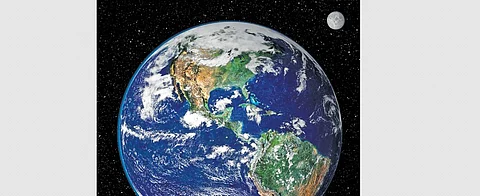

Never has mankind faced multiple environmental crises as the present generation. To quote the United Nations secretary-general António Guterres: “We have been poor custodians of our fragile earth. Today, the Earth is facing a triple planetary crisis. Climate disruption. Nature and biodiversity loss. Pollution and waste. This triple crisis is threatening the well-being and survival of millions of people around the world.”
The world has failed to achieve the internationally agreed environmental goals relating to climate change, biodiversity conservation and pollution. The Sixth Assessment Report of the Intergovernmental Panel on Climate Change released in 2022 notes that unless countries accelerate mitigation, the world is most likely to overshoot the global warming limits of 1.5°C or 2°C above pre-industrial levels which were agreed at the Paris Climate Summit in December 2015. The report warns that global average temperatures are likely to reach a median of 2.2 to 3.5°C by the year 2100, making us more vulnerable to catastrophic events and reducing global gross domestic product by 1.3 to 4.2 per cent by 2050.
Degradation of biodiversity and ecosystem services has continued unabated, if not accelerated. According to the Centre for International Forestry Research, the world loses $6.3 trillion worth of ecological services each year due to forest and land degradation.
A United Nations report notes that air pollution is the main environmental contributor to the global burden of disease, causing six to seven million premature deaths and welfare losses estimated at $5 trillion every year. Plastic pollution has emerged as a major problem with the world producing 400 million metric tons of plastic waste annually, of which only 9 percent is recycled; the rest is dumped into landfills, rivers, lakes and oceans.
The United Nations Environment Programme recently started on the seventh edition of the Global Environment Outlook report titled Actions for a Healthy Planet. The report focuses on finding solution pathways in the food, energy, materials or waste and economic sectors. Its emphasis is on bringing about transformative changes and innovative solutions in these sectors to realise the goal of a healthy planet.
In the energy sector, it focuses on improving access to clean energy especially among poor and vulnerable sections, and enhancing the development and adoption of energy-efficient technologies. Apart from phasing out fossil fuel use, the introduction of low greenhouse gas (GHG) emission technologies including sustainable and equitably-produced bioenergy, hydropower, solar and wind energy must be accelerated. The potential of green hydrogen needs to be tapped. This has important co-benefits for climate, air quality and human health.
Global population is projected to rise to 9.8 billion by 2050. With population and incomes rising, food production must be scaled up. Sustainable intensification of agriculture to raise crop yields, improvements in food distribution, and reduction in food loss and waste, which UN agencies currently peg at almost a third of food production, are other measures.
The Kunming-Montreal Global Biodiversity Framework for the period 2022–2030 calls for reducing the loss of bio-rich areas and critical ecosystems to near zero by 2030, ensuring the conservation of 30 per cent of all terrestrial and inland waters, and coastal and marine areas, restoring 30 per cent of degraded ecosystems, and reducing by half the threats posed by invasive species.
Rapid urbanisation is a major driver of global warming, biodiversity loss and pollution. By 2050, around 68 per cent of the world’s population will reside in urban areas. Establishing smart and sustainable cities that rely on modern digital technologies; engaging with citizens for addressing key sustainability challenges for cities such as transportation, consumption choices, energy, water and waste management; investing in mass rapid transit systems based on sustainably produced electricity; increasing the green cover; and conserving lakes in urban areas will help in reducing urban heat islands and managing stormwater and extreme weather events such as floods.
Without behavioural and lifestyle changes by individuals and societies it will be difficult to reverse the present trajectory of rapid environmental degradation. Shifting towards sustainable and healthier diets will protect the environment and humans’ health. Increasing consumption of millets and replacing natural meat with cultured and lab-grown meat are among the measures recommended for lessening pressure on land, water and forest resources as well as reducing GHG emissions.
The zero-pollution action plan seeks to make ecosystems healthy by drastically reducing air, water and soil pollution by 2050. Tightening regulatory mechanisms and effectively implementing them are key to achieving this vision. Sustainable agriculture also needs a reduction in the nitrogen and phosphorus imbalance to reduce pollution of freshwater systems, groundwater, and coastal zones in oceans.
Improving the data and knowledge base, integrating traditional knowledge and citizen science with science-based information, and exploiting the potential of emerging data sources and technologies will help to better monitor environmental change and formulate effective policies to address the environmental crisis.
Other measures include disincentivising unsustainable practices and environmentally harmful subsidies; introducing policies to improve resource use efficiency; upscaling local-level transformative projects and innovative solutions; improving public awareness about sustainability-driven consumer choices; creating an enabling environment for niche innovations; and phasing out unsustainable products and industrial processes.
These measures will help bring about a transformation in societies’ relationship with nature by 2030, in line with the 2030 Agenda for Sustainable Development and its Sustainable Development Goals, and ensure that by 2050, the shared vision of living in harmony with nature is fulfilled.
K N Ninan
Lead Author, Global Environment Outlook-7, United Nations Environment Programme, Nairobi
(ninankn@yahoo.co.in)